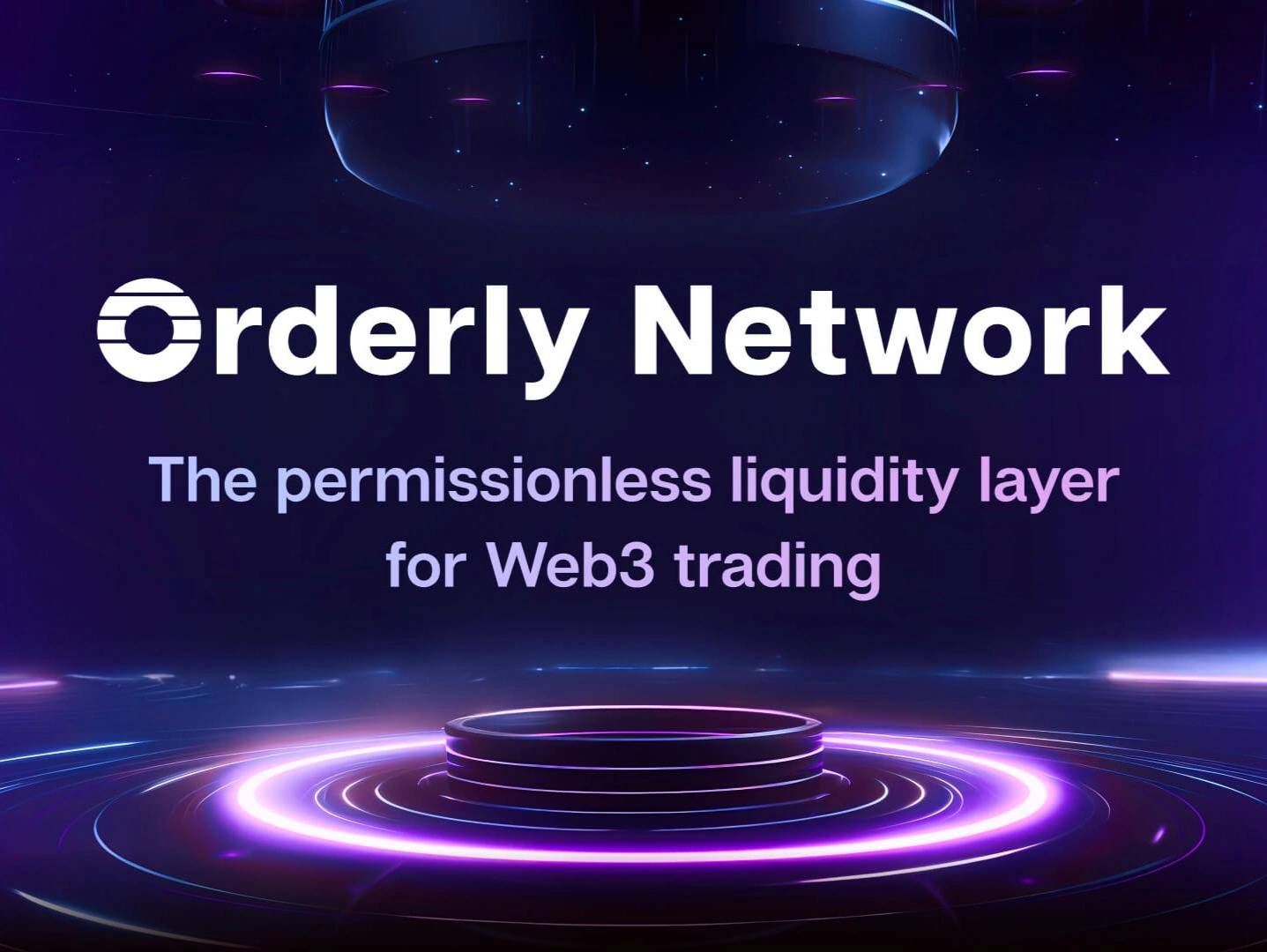订阅 wiki
Share wiki
Bookmark
Orderly Network
Orderly Network
Orderly Network 是一个为 Web3 交易应用程序设计的无需许可的全链流动性层。它作为一个去中心化交易所协议运行,提供后端基础设施,包括共享订单簿,使开发者能够构建性能与中心化交易所相媲美的现货和永续期货交易平台。 [1] [2]
概述
Orderly Network的开发旨在解决去中心化金融(DeFi)中普遍存在的流动性碎片化和不良用户体验问题。该协议作为构建在OP Stack上的Layer 2(L2)解决方案运行,从而为交易操作提供高吞吐量和低延迟。其核心组件是一个中央限价订单簿(CLOB),该订单簿在构建在其基础架构上的所有去中心化应用程序(dApps)之间共享。该模型创建了一个深度统一的流动性池,从而无需各个项目来引导他们自己的流动性。 [3] [2]
该项目的愿景是创建一个全链交易环境,用户可以在其中交易来自任何受支持的区块链的任何资产,而无需手动在网络之间桥接资金。通过抽象跨链交互的复杂性,Orderly旨在提供类似于传统中心化交易所(CEX)的无缝交易体验,同时保留DeFi的自我托管和链上结算原则。该基础架构被设计为白标解决方案,为开发人员提供软件开发工具包(SDK)和API,以构建和自定义他们自己的交易前端、钱包和其他金融应用程序。这种方法使合作伙伴可以专注于用户获取和界面设计,同时利用Orderly强大的后端进行交易执行和流动性。 [1] [3]
历史
Orderly Network 的公开亮相始于 2022 年 1 月创建的官方 X(前身为 Twitter)帐户。该项目随后推出了其主页,并推出了其原生代币 ORDER,以促进与其生态系统的互动。早期的一个关键事件是世界交易大赛 (WSOT) 的结束,这是一项大规模的交易竞赛,展示了该网络处理大量活动的能力。 [5] [2]
2024 年 12 月,Orderly Network 在 Solana 主网 上推出了其全链订单簿。此次部署意义重大,因为它首次将 EVM 和非 EVM 订单合并到一个永续订单簿中,使 Solana 用户无需桥接或包装资产即可直接与 EVM 链上的参与者进行交易。 [4]
2025 年 3 月,Orderly 将其全链交易基础设施与 Story 集成,Story 是一种旨在将知识产权代币化的 Layer 1 区块链。此次合作使在 Story 上构建应用程序的开发人员能够按需访问 Orderly 的深度流动性,从而促进音乐版税或专利等代币化 IP 资产与其他支持链上的流动性池的交易。 [5]
2025 年 5 月,该网络通过启动一项追溯奖励计划,进一步深化了与 Solana 生态系统的集成。超过 230 万个托管 ORDER ($esORDER) 代币可供 Solana 上任何 Orderly 驱动的 DEX 上的过去交易者使用。该计划与 Orderly 的原生代币 质押 计划在 Solana 网络上的启动相结合。 [6]
2025年9月,该网络宣布了一系列重要的功能发布和集成。9月5日,USDC.e(Circle的桥接USDC标准)在Orderly Chain上线,这得益于与StargateFinance的集成,该集成将网络连接到超过55个其他区块链生态系统。9月17日,该协议在Solana 区块链上推出了多抵押品功能,允许交易者使用SOL和USDT作为永续合约交易的抵押品。该网络声称这是DeFi协议首次在Solana和EVM环境中实现多抵押品永续合约交易。此功能于9月19日扩展到BNB Chain,增加了BNB作为超过133个交易对的抵押品选项。同期,与投资组合跟踪器DeBank的集成受到关注,允许用户查看他们在Orderly的OmniVault中持有的余额。9月23日,该网络推出了Orderly ONE,这是一个无需代码的平台,允许用户在几分钟内构建和启动自己的永续合约DEX。当月晚些时候,即2025年9月29日,ORDER代币在韩国主要的加密货币交易所Upbit上市,支持BTC和USDT交易对。消息发布后,该代币的价格飙升70%,达到0.41美元的历史新高,24小时交易量达到近3亿美元的纪录。[5] [9] [10] [12] [13] [15]
技术
Orderly Network 的基础设施旨在将链下订单撮合的效率与链上结算的安全性相结合,所有这些都在一个全链框架内。
架构
该协议构建于 OP Stack 之上,OP Stack 是一个用于创建乐观 Rollup 的开源开发堆栈。这个基础为其交易引擎提供了一个可扩展且安全的环境。架构的核心是中心限价订单簿 (CLOB),这是一种传统的交易模型,以指定的价格匹配买单和卖单。虽然订单簿本身在高性能的链下环境中运行,以确保低延迟,但所有最终交易结算和资金管理都在链上进行。这种混合方法使 Orderly 能够在不影响用户自托管的 DeFi 原则的情况下,提供 CEX 级别的交易体验,因为用户始终可以在自己的钱包中保留对其资金的控制权。该架构被设计为去中心化的,将数据和操作跨多个节点分布,以防止单点故障。 [3] [2]
全链功能
Orderly Network 的一个中心目标是统一不同区块链生态系统之间的流动性。这通过其全链基础设施实现,该基础设施由其原生“Orderly Chain”和 LayerZero 等互操作性协议提供支持。这项技术允许网络从各种链(包括 Ethereum、Arbitrum、Polygon、Solana 和 NEAR)聚合流动性到一个单一的共享订单簿中。对于用户而言,这意味着他们可以交易来自不同链的资产,而无需执行手动跨链交换或桥接。例如,EVM 兼容链上的用户可以直接与 Solana 上的用户在同一个订单簿中进行交易。与 StargateFinance 的集成通过实现从数十个连接的生态系统直接到 Orderly Chain 的 USDC.e 等资产的无缝、零费用入站传输,进一步增强了此功能。 [2] [5]
主要特点
Orderly Network 提供了多项功能,旨在提高交易者和开发者的资本效率和用户体验。
- 多抵押品交易: 此功能允许交易者使用多种类型的资产作为其永续期货头寸的抵押品,而无需先将其转换为稳定币。这通过允许用户直接杠杆其现有资产来提高资本效率。截至 2025 年 9 月,支持的抵押品资产包括 SOL、USDT 和 BNB,在 Solana 和 BNB Chain 等链上。[5]
- 共享流动性: 所有在 Orderly 上构建的 dApp 和前端都利用相同的深度流动性池。这解决了新 DEX 的一个主要挑战,它们不再需要从头开始吸引自己的流动性提供者。[3]
- 开发者工具: 该网络为开发者提供了一个全面的软件开发工具包 (SDK) 和 API。SDK 允许创建定制的用户界面和交易应用程序,该网站声称它可以为开发团队节省每次集成超过 200 小时的时间。API 为算法交易者、交易平台和机器人提供对订单簿的直接访问。[1]
- Orderly ONE(构建您自己的 DEX): Orderly ONE 于 2025 年 9 月推出,是一个无需代码的平台,允许包括 DAO、基金和交易社区在内的用户在几分钟内创建和启动高性能的永续 DEX。该平台支持超过 17 个主要的区块链。虽然创建 DEX 是免费的,但需要支付 1,000 美元(或以 ORDER 代币的折扣等值)才能为创建者启用费用收入。[12] [13]
- 高级订单类型: 该平台支持标准限价单以及更高级的类型,如止损 (SL) 订单,为交易者提供必要的风险管理工具。[3]
- OmniVault: 这是 Orderly 的旗舰策略金库,被设计为一种全链和无需许可的解决方案,以放大流动性并创造新的收益机会。用户可以将来自任何支持链的 USDC 等资产存入 OmniVault,成为流动性提供者。金库的资产由专业的第三方做市公司管理,这些公司被称为策略提供商(Kronos Research 是第一家),他们执行做市策略。流动性提供者 然后获得金库利润和损失的按比例份额,从而获得以前零售用户无法获得的策略收益。金库的智能合约已经过多次独立的安全性审计,报告已在 GitHub 上公开,以确保资产安全。OmniVault 中持有的余额可以通过 DeBank 等外部投资组合管理工具进行跟踪。[7] [5]
Tokenomics
Orderly Network生态系统的原生实用代币是ORDER。它是一种基于以太坊区块链的ERC-20代币,旨在分散协议、激励用户参与并协调所有利益相关者的利益。 [8]
- 代币代码: ORDER
- 区块链: 以太坊
- 合约地址:
0xABD4C63d2616A5201454168269031355f4764337 - 最大供应量: 1,000,000,000 ORDER
- 总供应量: 1,000,000,000 ORDER
- 流通供应量: 截至2025年末,约为296,580,787 ORDER。 [2]
代币效用
ORDER代币的主要效用集中在治理、质押和激励方面。
- 治理: ORDER质押使代币持有者能够参与协议的去中心化治理。这使他们能够在治理过程正式化后,影响有关平台方向和政策的关键决策。 [8]
- 质押和费用分享: 主要效用是质押,这使持有者能够赚取协议收入的一部分。在Orderly支持的每个链上收取的交易费用的60%将分配给ORDER质押者。通过在像Solana这样的低成本链上进行质押,用户可以访问来自整个全链网络的奖励,该网络已经向超过4,200名活跃质押者分配了超过1000万美元的费用。[6]
- 奖励提升: 质押ORDER可以提升活跃网络参与者的奖励。交易者和做市商都可以质押ORDER,以获得更高的交易和做市奖励份额,从而直接激励持有和质押代币。[8]
- 赚取VALOR: 质押者还可以赚取VALOR,这是一种衡量用户质押头寸的指标,基于其质押的数量和持续时间。VALOR使用户有权获得协议金库的相应份额。[8]
esORDER
代币经济学还包括esORDER(托管ORDER),这是一种在交易者和做市商的奖励系统中使用的代币形式。收到esORDER后,用户有两个主要选择:质押它以获得与质押流动性 ORDER相同的收益,或者将其归属以在一段时间内转换为流动性 ORDER。[14]
将esORDER转换为ORDER的赎回过程涉及线性归属计划。用户可以选择15到90天的归属期限。
- 最短归属期: 15天的归属期允许用户解锁其代币的50%。
- 最长归属期: 90天的线性归属期允许用户解锁其代币的100%。
当用户在完整的90天期限到期之前赎回esORDER时,未归属的代币部分将被永久销毁并从流通中移除。例如,如果用户在最短的15天期限后赎回100个esORDER,他们将收到50个流动性 ORDER,剩余的50个ORDER将被销毁。这种机制旨在分散抛售压力,并对代币供应产生通货紧缩效应。[14]
为了奖励早期采用者,Orderly进行了追溯性空投。在2025年5月,为Solana交易者启动了一项重要的追溯性奖励计划,向之前在网络上任何Orderly驱动的DEX上进行过交易的用户提供了超过230万个esORDER。该协议计划每两周分发额外的esORDER奖励,以继续激励Solana上的交易活动。[6]
交易所上市
ORDER代币可在各种中心化和去中心化交易所进行交易。2025年9月29日,该代币在韩国主要交易所Upbit上市。该上市支持BTC和USDT交易对,存款仅通过以太坊网络进行。此次上市对市场产生了重大影响,导致代币价格飙升至历史新高,并推动其交易量达到近3亿美元的纪录。 [9] [11] [15]
生态系统
Orderly Network的生态系统由建立在其基础设施之上的dApp、其财务支持者和技术合作伙伴组成。
构建者和dApp
作为一个后端基础设施提供商,Orderly Network 支持各种前端应用程序,这些应用程序利用其流动性和交易引擎。这些“构建者”包括去中心化交易所、钱包和交易终端。在 Orderly 上构建的著名项目包括:
该列表代表了超过 50 个已与该网络集成的项目,旨在向其用户提供永续期货交易。 [1] [5]
投资者和支持者
Orderly Network 的发展得到了 加密货币 行业众多风险投资公司和战略合作伙伴的支持。主要投资者包括 Pantera Capital、Dragonfly Capital、Sequoia Capital、GSR、Jump Crypto、Crypto.com Capital、IOSG Ventures、SevenX Ventures、Amber Group、Kronos Research、Gate Ventures、Laser Digital(野村证券子公司)和 CoinDCX。 [1]
技术合作伙伴
Orderly Network 与各种 区块链 网络和协议集成,以实现其全链功能。其基础设施建立在主要的链上,如 Arbitrum、Optimism、Ethereum、Polygon、Solana、Base、Mantle、Sonic 和 NEAR。关键技术合作伙伴包括 LayerZero(用于跨链消息传递)和 StargateFinance(用于资产桥接)。另一个关键合作伙伴是 Story,这是一个用于代币化知识产权的 Layer 1 区块链。这种集成(于 2025 年 3 月宣布)使 Story 生态系统中的开发者能够利用 Orderly 的跨链流动性框架来交易代币化的 IP 资产。该项目还与 Google Cloud 合作,后者支持其 SDK 并参与了与 Empyreal 公司的联合 AI 赏金计划。 [1] [2] [5]
使用案例
该协议的基础设施被设计为可组合且多功能,支持 DeFi 领域的各种应用 across。
- 经纪商: 项目可以使用 Orderly 的白标解决方案,在 EVM 链和 Solana 上启动他们自己的品牌永续合约 DEX,而无需从头开始构建后端。
- 永续合约聚合器: 聚合器可以创建一个单一的前端,利用整个 Orderly 生态系统的共享流动性,为用户提供有竞争力的执行。
- 钱包和托管人: 钱包可以集成由 Orderly 驱动的交易或兑换小部件,允许他们的用户直接从钱包界面进行交易。
- 交易平台和资深交易者: 交易平台和资深交易者可以通过 API 直接连接到订单簿,以实现高速、自动化的交易策略。
- 游戏和 dApp: GameFi 项目和其他 dApp 可以嵌入游戏内兑换小部件,以方便代币交易,而无需用户离开应用程序。
- 交易机器人: 开发者可以将交易机器人连接到订单簿,以访问有竞争力的永续合约价格,利用限价单和无 gas 交易等功能。
- 对冲: 交易者可以使用该平台的订单簿对冲他们在其他中心化或去中心化交易所持有的头寸。 [3]
团队
Orderly Network 的创始团队成员包括在区块链技术、去中心化金融和战略发展方面拥有经验的个人。
- Ran Yi: 以提供战略见解和指导网络整体愿景而著称。
- Terence Ng: 在区块链技术方面贡献了丰富的经验,专注于项目的技术架构。
- Arjun Arora: 带来了去中心化金融(DeFi)方面的专业知识,以增强平台的产品能力。 [2]
安全性
Orderly Network 通过其去中心化架构和第三方审计来强调安全性。该协议的设计将操作跨多个节点分布,以降低单点故障的风险。为了确保其智能合约和基础设施的完整性,该项目已经接受了多家公司的安全审计,包括 Zellic 和 CertiK。审计报告在项目的 GitHub 存储库中公开提供,以提高透明度。 [1] [2]
发现错误了吗?
